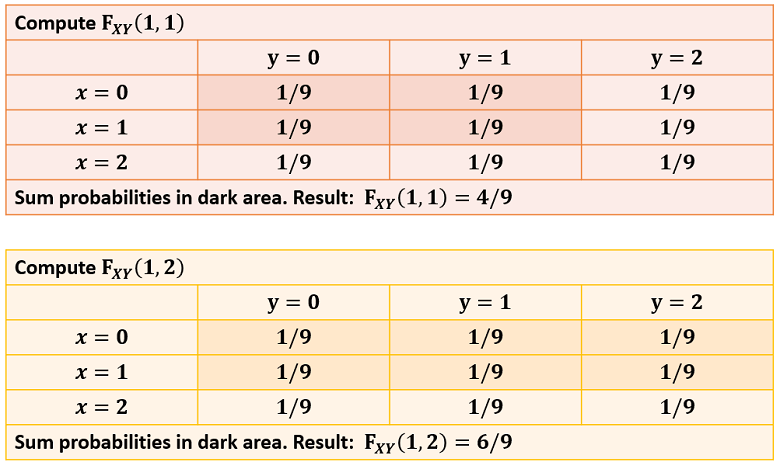Joint Distribution of Discrete and Continuous Random Variables
The joint distribution function is a function that completely characterizes the probability distribution of a random vector.
Table of contents
-
Synonyms and acronyms
-
Joint cdf of X and Y
-
Example
-
The formula for discrete variables
-
How to compute the formula with a table
-
The formula for continuous variables
-
Example
-
-
How to derive the marginal cdfs from the joint
-
Deriving the joint cdf from the marginals
-
Joint cdf of two independent variables
-
A more general definition
-
More details
-
Keep reading the glossary
It is also called joint cumulative distribution function (abbreviated as joint cdf).
Let us start with the simple case in which we have two random variables and
.
Their joint cdf is defined as where
and
are two real numbers.
Note that:
-
indicates a probability;
-
the comma inside the parentheses stands for AND.
In other words, the joint cdf gives the probability that two conditions are simultaneously true:
-
the random variable
takes a value less than or equal to
;
-
the random variable
takes a value less than or equal to
.
Suppose that there are only four possible cases:
Further assume that each of these cases has probability equal to 1/4.
Let us compute, as an example, the following value of the joint distribution function:
The two conditions that need to be simultaneously true are:
There are two cases in which they are satisfied:
Therefore, we have ![[eq7]](https://statlect.com/images/joint-distribution-function__16.png)
In the previous example we have shown a special case.
In general, the formula for the joint cdf of two discrete random variables and
is:
![[eq8]](https://statlect.com/images/joint-distribution-function__19.png) where:
where:
The probabilities in the sum are often written using the so-called joint probability mass function
The sum in the formula above can be easily computed with the help of a table.
Here is an example.

In this table, there are nine possible couples and they all have the same probability (1/9).
In order to compute the joint cumulative distribution function, all we need to do is to shade all the probabilities to the left of (included) and above
(included).
Then, the value of is equal to the sum of the probabilities in the shaded area.
When and
are continuous random variables, we need to use the formula
![]() where
where is the joint probability density function of
and
.
The computation of the double integral can be broken down in two steps:
-
first compute the inner integral
which, in general, is a function of
and
;
-
then calculate the outer integral
Example
Let us make an example.
Let the joint pdf be ![[eq17]](https://statlect.com/images/joint-distribution-function__42.png)
When and
, we have
![[eq20]](https://statlect.com/images/joint-distribution-function__45.png)
This is only one of the possible cases. We also have the two cases:
-
or
, in which case
-
and
, in which case
![[eq22]](https://statlect.com/images/joint-distribution-function__51.png)
The two marginal distribution functions of and
are
They can be derived from the joint cumulative distribution function as follows: where the exact meaning of the notation is
This can be demonstrated as follows: ![]() because the condition
because the condition is always met and, as a consequence, the condition
is satisfied whenever
is true.
The proof for is analogous.
In general, we cannot derive the joint cdf from the marginals, unless we know the so-called copula function, which links the two marginals.
However, there is an important exception, discussed in the next section.
When and
are independent, then the joint cdf is equal to the product of the marginals:
See the lecture on independent random variables for a proof, a discussion and some examples.
Until now, we have discussed the case of two random variables. However, the joint cdf is defined for any collection of random variables forming a random vector.
Definition The joint distribution function of a random vector
is a function
such that:
![]() where the entries of
where the entries of and
are denoted by
and
respectively, for
.
More details about joint distribution functions can be found in the lecture entitled Random vectors.
Previous entry: Integrable random variable
Next entry: Joint probability density function
Please cite as:
Taboga, Marco (2021). "Joint distribution function", Lectures on probability theory and mathematical statistics. Kindle Direct Publishing. Online appendix. https://www.statlect.com/glossary/joint-distribution-function.
quintanasurew1950.blogspot.com
Source: https://statlect.com/glossary/joint-distribution-function
0 Response to "Joint Distribution of Discrete and Continuous Random Variables"
ارسال یک نظر